 Current Infrastucture News Current Infrastucture News
Archive of Infrastucture News: 2013-14 - 2015-16 - 2017 - 2018 - 2019 - 2020 - 2021-22 - 2023
Archive Reports: Northern Extension Project -
Permanent Way and Lineside News (2007-2011) - P-Way News (2002-4)


Extending the Bluebell Railway
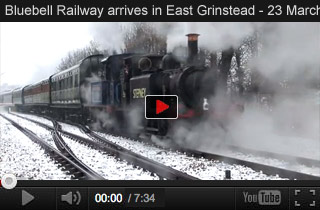 The Bluebell Railway's Extension to East Grinstead Opened on 23 March 2013
The Bluebell Railway's Extension to East Grinstead Opened on 23 March 2013
Nicholas Owen narrates this official Bluebell video, recording the completion of our Northern Extension Project which has taken 39 years and cost about £11 Million, almost all raised by and from the Bluebell's membership and the public. The footage was captured on the opening day, 23 March 2013, when the Bluebell Railway's first public steam trains were run out of, and into, East Grinstead station.
|
Click here for the Full details of all the work undertaken on
the East Grinstead Extension.
 The Bluebell Railway re-opened in 1960, preserving a five-mile
stretch of the former Lewes to East Grinstead line between Sheffield
Park and Horsted Keynes. Until 1963, electric trains from Haywards
Heath still linked with the Bluebell at Horsted Keynes on the branch
line via Ardingly. The map shows the stations and railway lines in
the area.
The Bluebell Railway re-opened in 1960, preserving a five-mile
stretch of the former Lewes to East Grinstead line between Sheffield
Park and Horsted Keynes. Until 1963, electric trains from Haywards
Heath still linked with the Bluebell at Horsted Keynes on the branch
line via Ardingly. The map shows the stations and railway lines in
the area.
In the first decade of the Bluebell's existence, operating the
railway and the purchase of the freehold of the existing line were
the priorities. It was only in 1974, when the site of the demolished
West Hoathly station came up for sale, that the first steps towards
an extension northwards were taken. These culminated in a public
enquiry, and the Secretaries of State for the Environment and
Transport finally gave planning permission and a Light Railway Order
for an extension to East Grinstead in 1985.
The first mile north from Horsted Keynes opened in 1990, followed two
years later by the stretch through Sharpthorne Tunnel to the former
West Hoathly Station site. Just north of here a new three-span
girder bridge had to be built. In 1994 the railway was re-opened to
Kingscote, the station building there having been purchased in January 1985.
There then followed a period of consolidation before the final push
to East Grinstead.
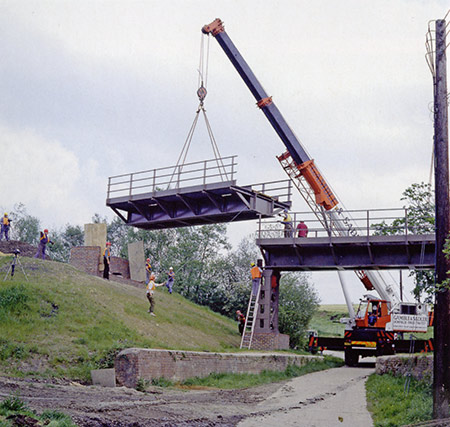 Right: The Construction of New Coombe Bridge.
Right: The Construction of New Coombe Bridge.
A big problem was the number of individual land owners who had to be persuaded to sell their land to us, and it was only in 2003 that we obtained the final piece of land to clear our way north, resulting in the start of tracklaying in September 2003.
The Imberhorne (or Hill Place) Viaduct, just south of East Grinstead, was sold to the Bluebell for a nominal sum by British Rail just at the time of de-nationalisation. As a maintenance liability, the quid-pro-quo was an agreement to sell us the required station site for a nominal sum at a later date. The viaduct has been thoroughly repaired and now has track over it again. The site earmarked for a Bluebell station in the old
station goods yard at East Grinstead was only just large enough for a small platform, and we were subsequently able to negotiate just enough extra land to enable a 7-coach length platform, and then built a platform and run-round loop ready for trains to arrive from the South. East Grinstead Town Council
have been keen to see the Bluebell both contributing to the
local transport infrastructure, and acting as a means of increasing
the number of visitors to this historic market town, and over recent years have been most supportive.
The main obstacle was Imberhorne tip. Some 300,000 cu.m of domestic waste was tipped into the railway cutting in the late 1960s and early 1970s. Removal of this waste was the only realistic option to allow the railway through. The cost was estimated to be in the region of £4 million. Following all the necessary consents required to remove the waste, and complex negotiations regarding the potential future requirement to bridge the cutting if the putative East Grinstead bypass is routed that way, the cutting was transferred into Bluebell ownership from West Sussex County Council. Once these hurdles were overcome we could make a start on excavation, and the fund-raising required to carry it out. Initially 15,000 tonnes was removed by road, but then with the recession the balance swung in favour of using otherwise idle capacity on rail, and thanks to a partnership with Network Rail, GB Railfreight, Shanks and L&W, and the ability to create our main-line connection end-on to the siding at East Grinstead, and with our own run-round loop created on our station site, and track laid up to the tip, the remainder was extracted by rail.
We had to work very hard to raise the money required to fund the extraction, starting with a share issue which raised £670,000, Tenner for the Tip and Fiver for the Finish schemes (£300,000 raised), a Big Give Christmas Challenge and two hugely successful "Double Donation Dashes" (the Challenges/Dashes both involving major donors putting up substantial potential sums which would be matched by smaller donations from the membership), as well as taking various actions to reduce those costs from an initial £38 per tonne of waste removed down to, at the end, just £24. Our e-mail discussion list themselves raised enough money to run two waste trains (each train-load cost £24,000 to remove), the first of which was celebrated as the "Chit Chat Express".
By the 1 April 2012 deadline of the ending of the Landfill Tax Exemption Scheme we have, at a cost reduced to £2.715 million, cleared 90,000 tonnes of domestic waste, which was enough, when combined with the re-engineering of the cutting and track profiles, to enable us to lay the track through and re-open the line. This left us needing to raise £800,000 during 2012 Funding for the Finish campaign, to enable us to deal with the remaining earth-moving, completion of the signalling, including expensive immunisation of track circuits due to the proximity to the national electrified network, completion of our facilities at East Grinstead, some further work on the viaduct and one of the bridges, and completing the track between Kingscote and East Grinstead to passenger-carrying standards. With the trackwork delayed by 12 weeks due to appalling weather, it was touch and go for the planned opening date, but by a lot of hard work, close cooperation between contractors and volunteers, and determination to get the job done, the rails were linked up on 8 March (see this video of the "White Fishplate" moment), leaving just a couple of weeks for ballasting and tamping of the track, completion of the signalling and communications links, staff training, and safety verification, leading to the re-opening of the line on 23 March 2013, with temporary station facilities (travel centre, restaurant/shop carriage, toilets and booking office) also installed ready for the opening day.
That was not the end of it - there remained some less urgent jobs to complete - the water tower, the canopy over the booking office windows, capping off of the last of the cutting side, removing surplus capping material to elsewhere on the line, and other tidying of the trackside.
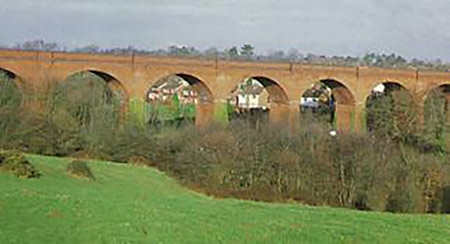 Imberhorne Viaduct.
Imberhorne Viaduct.
The contract for the refurbishment of Imberhorne Viaduct was let in
the Summer of 2002,
the cost covered by contributions received under the
Landfill Tax Credit Scheme. The work involved the re-pointing and
repair of brickwork, re-waterproofing of the structure and the
replacement of the coping stones on the viaduct where these have been
dislodged by vandals in the past. Many of the coping stones for this
have been recovered from our land beneath the viaduct.
Volunteer teams have cleared the trackbed of dumped machinery, trees and a pond, and have installed drainage and fences. All the trackbed is now clear, and much of it fenced and drained. A bridge and a cattle creep north of the tip have been subject to considerable work.
In 2004 track was laid northwards from Kingscote to the end of the tip, and during 2005/6 inert spoil which was not part of the main rubbish tip, has been removed by train southwards (as seen in the photos below). The spoil has been used to rebuild the cut-back embankment of the Ardingly spur at Horsted Keynes, and was then used to fill a small part of the "triangle" to the south of Horsted Keynes station.
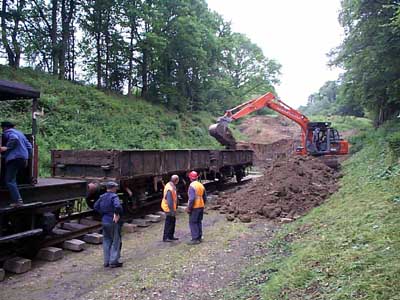
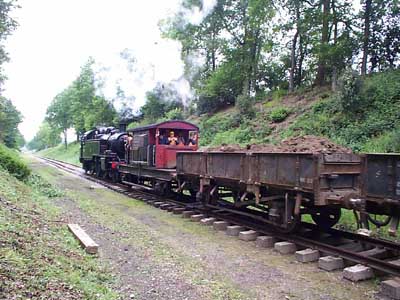
The 2008 share offer raised £670,000. This enabled the purchase of the tip site, preparation of the facilities for extraction, many legal and insurance payments to be made, and a tenth of the tip was extracted by road over a three week period, which enabled more accurate planning for the remaining extraction. The funds raised also paid for the removal of the remainder of the inert spoil, which could not be removed until the main site was in our ownership.
During 2009 and early 2010 a lot of work was done to enable waste extraction by rail, which thanks to industry-wide cooperation became an affordable option. The track layout planned for our platform at East Grinstead was required to accommodate the waste trains, and before laying tracks into the station area, we needed to build the platform (since that would be almost impossible after tracks were laid), and so we have been able to complete the platform and run events and open days at the station since then.
Through 2010 and 2011, up to the end of the fifth phase of the "Waste by Rail" operation in November/December 2011, waste has been leaving by train northwards, via our connection to the main-line at East Grinstead. This has involved an enormous and very successful fund-raising effort, which continued until enough waste had been cleared (the effective deadline being the ending of the Landfill Tax Exemption Scheme at the end of March 2012 after which costs would have quadrupled).
Having therefore completed the removal of sufficient waste, work commenced in March 2012 to profile the track levels and embankment sides in the cutting at Imberhorne Lane bridge. Drainage and cable routes have been installed and the track reinstated to its new approach gradient up to Imberhorne Lane bridge. Work has also been undertaken at Kingscote North on constructing the final track and pointwork. This is a major project in itself and a quite complex job. Facilities, both for the public and for watering locos, are being prepared for East Grinstead, and the signalling system, and its associated power supply and emergency generator for the extension has been commissioned. Brickwork and safety fencing at several bridges has been repaired or installed, and final repairs to one section of the viaduct is being completed.
So with the final waste moved from the cutting, the engineering work completed on the cutting sides, track laid, crew training, and all the paperwork approved, the extension was able to open on 23 March 2013.
The full story of the work undertaken to extend the line from Kingscote to East Grinstead is available on the Extension Work Progress Page.
Westwards?
In 1997 the Bluebell Railway safeguarded a long-term option for the
future with the purchase of the trackbed from Horsted Keynes
to the Railtrack boundary at Ardingly. The opportunity was felt to
be one not to be missed, even though current priorities are in the
East Grinstead direction. An eventual extension to Ardingly or
Haywards Heath is thus kept open as a long term possibility. There
is no intention of carrying out more than preventative maintenance of
the trackbed and structures in the short term, and this work has
already been started by a team of volunteers.
The official position and plans for this potential extension are detailed in Section 5 of the BRPS Long Term Plan. In essence the policy is currently to do what is required to ensure the option of re-opening the line is safeguarded. This is limited to applying for the relevant permissions to be able to construct the line, and thus be in a position to take possession of the tunnel.

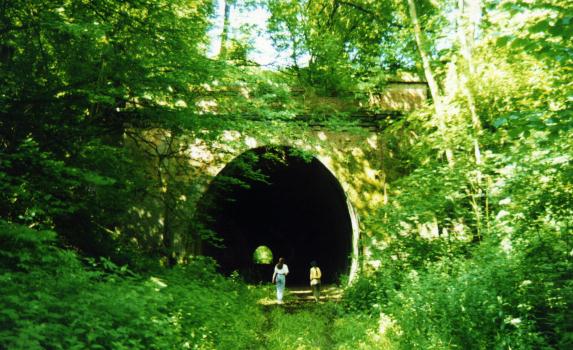
Left: The 1997 sponsored walk took us through Lywood Tunnel. It is now fenced off, preventing access, at the requirement of our insurance company.
The trackbed is in good condition although repairs are required to a
collapsed culvert. The short Lywood Tunnel appears to be in good
condition, and has now been taken over on a lease with option to purchase. The purchase was funded initially with a loan from a
member and a wonderful response to an appeal to the membership. The
land became available due to the break-up of the estate of which it
was part, although complicated by a short length of the trackbed
being in the ownership of another member of the same family.
The two
major areas of work that would be required to re-open the line are
the replacement of a missing short girder-bridge span, and the
replacement of the small Sherriff Mill viaduct, the condition of
which was one of the reasons the line was closed in 1963. It was
demolished in 1969, but we will be able to bridge the gap by
extending the embankments and using two long bridge sections which have been obtained.
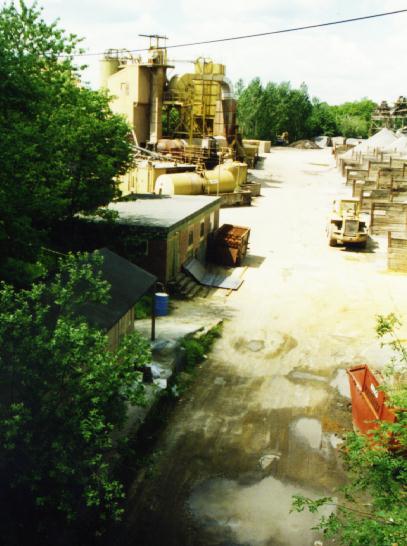 Right: The aggregates depot in the former Ardingly Station goods
yard, and the remains of station platform.
Right: The aggregates depot in the former Ardingly Station goods
yard, and the remains of station platform.
The branch, with only one intermediate station, was electrified in
the 1930s, and initially 2-NOL units were used for the
Seaford-Horsted service. In the final years up to 1963 the line was
served by 2-HAL and 2-BIL units which connected with Bluebell Railway
steam trains at Horsted Keynes. In the last years before closure the
line was singled, with the other track used for stock storage, most
notably the new Kent Coast electric stock prior to its introduction,
and subsequently the steam stock that it replaced, awaiting
scrapping.
The stub of the line from Haywards Heath now serves an
aggregates depot at Ardingly, which occupies the former station platforms and goods yard. This has seen recent re-investment in plant, and there are several incoming aggregates trains a week. However we should be able to extend through this site to re-connect with the main line, since a route along the edge of the site for our track has been safeguarded. In the shorter term (i.e. at some stage in the next decade), we might build a platform on our own land east of the original site. The station building survives complete, although altered internally, up at road-level.
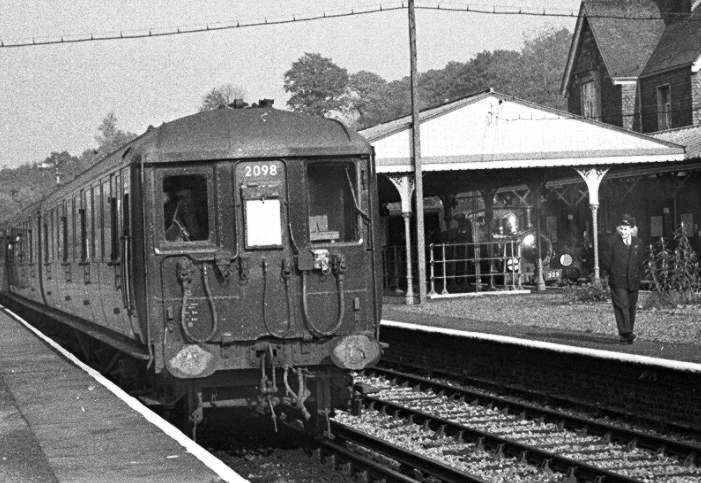
A reminder of the days when the Bluebell shared Horsted Keynes with
electric trains.
Keith Harwood took this photo of 2-BIL electric unit No 2098 at
Horsted Keynes in the early 1960s. No.323 "Bluebell" is visible on
what was then the Bluebell side of the station.
The re-signalling work undertaken at Horsted Keynes includes
provision for the eventual re-laying of the line to Ardingly.
The option of re-electrifying the branch, for use by preserved
electric trains as well as our own steam trains has been suggested by
many people. This has not been ruled out, although the replacement of all existing track circuits over the whole of the area controlled by Horsted Keynes Signal Box would make it an expensive undertaking, and very obviously, significant electrical safety concerns would need to be addressed.
It is clear however that the Bluebell's first priority, having focussed for several decades on the Northern Extension, has to be significant investment in the infrastructure of the remainder of the line, and our engineering and visitor facilities. Provision of a turntable is also a medium term objective. So any Westward extension would have to follow a period of consolidation. We'd also like to be able to construct a fitting and appropriate new station building at East Grinstead, if land can be obtained to achieve that.
Southwards?
A southward extension has long been considered impractical due initially to the difficulty in bridging the raised, widened and re-aligned A275 main road immediately south of Sheffield Park station. Whilst in the very
long term an extension south from Sheffield Park it might be feasible, that's really looking much too far
into the future for anyone to consider, for at least the next half century! We are however in support of the general principal that the remaining track bed is a potentially valuable transport corridor which should be safeguarded.
A further major obstacle is found at the A272 at Newick & Chailey, where the cutting and station site have been reclaimed, and are incorporated into people's gardens. Even if it were possible to purchase that land, the cutting is itself filled with a rubbish tip, and we're led to believe that the contents would not be as easy to dispose of as those at Imberhorne on our Northern Extension, since the Chailey site includes industrial waste and is also producing methane gas discharges. A more practical, but still very costly, alternative might be a diversion around the site on a new alignment, or simply running to a new terminus on the northern side of the road, but no surveys have been done or are currently planned to establish the feasibility of this.
The official position on extension southwards is detailed in Section 5 of the BRPS Long Term Plan.


Return to BRPS Home Page,
to the Timetable or to Special
Events
 Current Infrastucture News Current Infrastucture News
Archive of Infrastucture News: 2013-14 - 2015-16 - 2017 - 2018 - 2019 - 2020 - 2021-22 - 2023
Archive Reports: Northern Extension Project -
Permanent Way and Lineside News (2007-2011) - P-Way News (2002-4)
Visitor Info. -
Museum -
Trust -
Catering -
Contacts -
What's New -
Projects -
Locos -
Carriages & Wagons -
Signals -
History -
Other -
Links -
Search -
FAQ
Why not become a BRPS Member? -
Get more involved as a Volunteer
Your ideal Film/TV location?
 Last updated by Richard Salmon, 7 February 2023
Last updated by Richard Salmon, 7 February 2023
© Copyright BRPS. Privacy Policy
|














 The Bluebell Railway re-opened in 1960, preserving a five-mile
stretch of the former Lewes to East Grinstead line between Sheffield
Park and Horsted Keynes. Until 1963, electric trains from Haywards
Heath still linked with the Bluebell at Horsted Keynes on the branch
line via Ardingly. The map shows the stations and railway lines in
the area.
The Bluebell Railway re-opened in 1960, preserving a five-mile
stretch of the former Lewes to East Grinstead line between Sheffield
Park and Horsted Keynes. Until 1963, electric trains from Haywards
Heath still linked with the Bluebell at Horsted Keynes on the branch
line via Ardingly. The map shows the stations and railway lines in
the area.

 Imberhorne Viaduct.
Imberhorne Viaduct.
